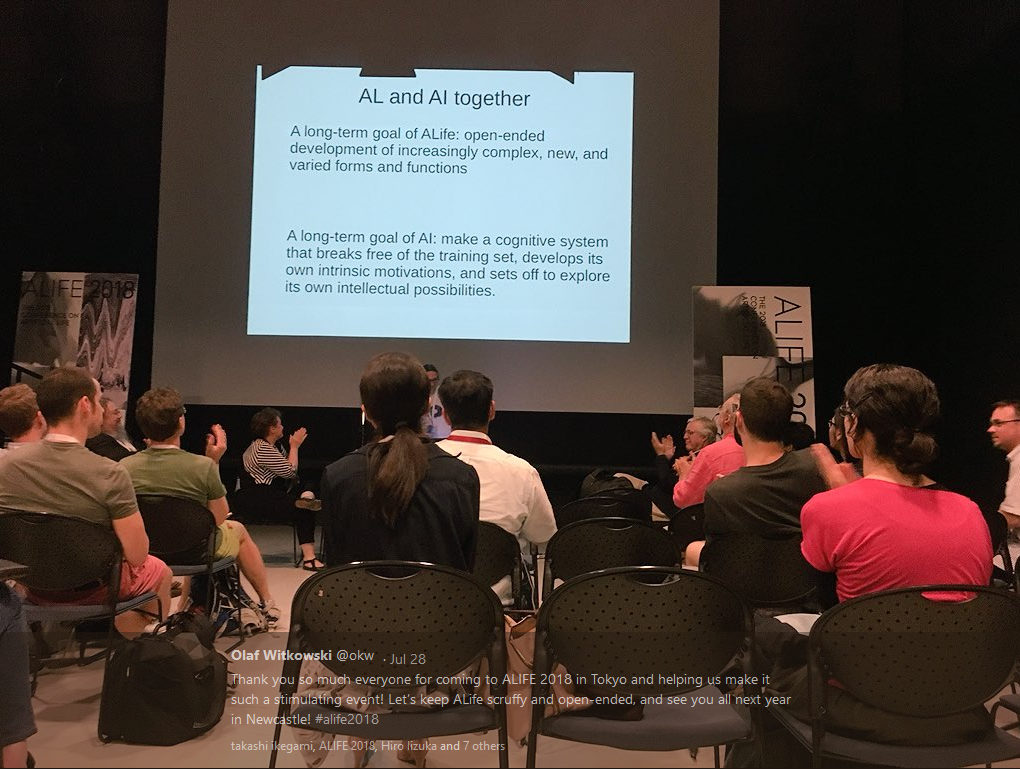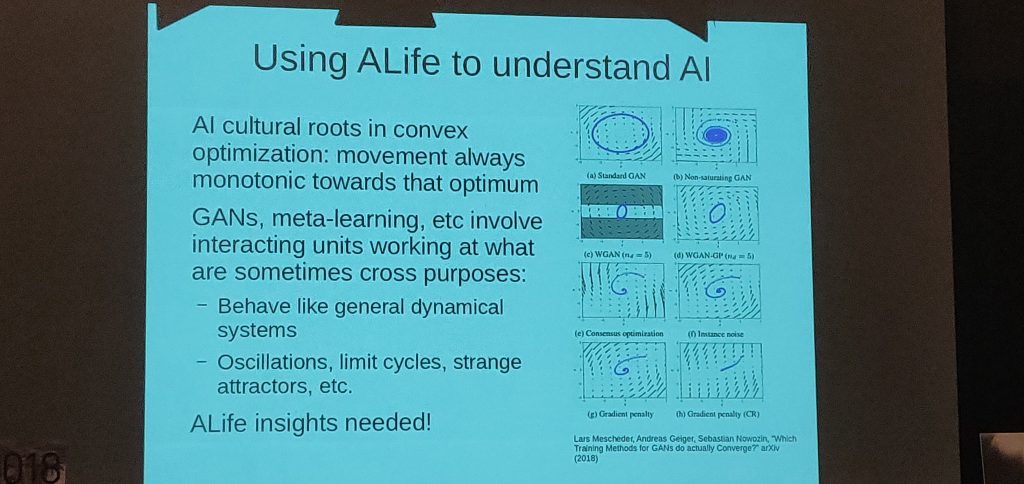ELSI @ ALIFE 2018
In a complex orchestra of art and science, chaos and order, uttered and experienced, punctuated by the ELSI session, ALIFE 2018 has left in its wake a sensation that we are collectively barking up (down?) the right gradient descent to understand the emergence of complexity, life, and the spectrum of its likely counterfactuals. Indeed, in understanding the causation of life, but also the origins and contingencies of our particular lives, a semblance of the counterfactuals must be realized. In this way understanding the origins of life requires us to imagine the origins of other possible lives. For example, what kind of genetic code could potentially emerge if you looked at Earth as but a single Earth in a thermodynamic Earth-ensemble? What kind of chemical networks would arise? Furthermore, how contingent is our particular form of life on details? Are humans a Christmas miracle? As downhill as equilibrium? Degenerate? How rare is life on the cosmic scale? How do we want to define life anyway? Are the words life, mind, consciousness, etc. all fuzzy metaphors for transient phases in embodied oscillators taking themselves too seriously? Should we be OK with fuzzy definitions? I’m taking some context from Rodney Brooks’ thoughts on being victims of metaphor in his Keynote talk balanced along with David OReilly’s thoughts on keeping definitions fuzzy for the sake and pursuit of art. I pose these questions to illustrate the mood, at least as I perceived it, during the ELSI session on the final day at ALIFE. A mood where we are starting to feel, outside the scope of words we’ve invented yet or sensations we’ve experienced yet, that the different branches of this vast forest of knowledge we have been traversing are starting to meet. This entangled web of inter-disciplinary fields of science and philosophy are beginning to speak to each other, at first in unintelligible dialects but slowly things are translating across.
Continuity
In Life, Mind, Sociality
Though the scientific pursuits to understanding what we call cognition versus what we call life can overlap, often for simplicity or pragmatism we try to look at these problems independently of each other. However, by loosening these boundaries up a bit as motivated by the embodiment movement, there seems to be a useful paradigm where life-like things and mind-like things can not just co-exist, but flourish. This perspective is perhaps best illustrated by Hanczyc & Ikegami when demonstrating the capability of simple self-moving oil droplets to act as a model of minimal cognition. Here, the interface/membrane of what constitutes the ‘individual’ is also physically the same interface/membrane that is involved with sensing and reacting to the environment. The oil droplet is defined (by us anyway) by the membrane it maintains in the face of a substance alien and potentially destructive to itself. The maintenance of the character of the droplet is then balanced recursively by its own character and motion, or put more succinctly, a homeodynamic process. In other words, through the example of the simple oil droplet, it can be better imagined how a system that exhibits autopoiesis could arise from humble origins and how proto-cognition and proto-life can co-exist and arise simultaneously.
This entangled continuity between life and mind may also extend naturally to sociality as well. This was demonstrated by Frose, Campos, Virgo in their work exploring the evolution of genetic codes in a population-based iterated learning paradigm. Their work suggests that certain key properties of the genetic code we observe in life today can arise naturally in the context of repeated horizontal interactions between protocells. These population-based iterated learning approaches add further evidence that movement, interaction, adaptive behaviour and now socialization already played a crucial role at the origin and initial evolution of life (Frose, Campos, Virgo). In what may be traditionally considered time-scale separated processes, a continuity is emerging suggesting that we ought to take their interactions more seriously. In some homeodynamic yet open-ended way, individuals work to forge communities while communities work to forge individuals with languages emerging as robust codes to path meaningful homeodynamic interactions. It seems inevitable then that to understand the core elements of life one must also be willing to simultaneously understand things that intuition might suggest are scale separated, like the emergence of individual agents, to cognition, and to socialization. This intuition-jogging observation suggests to us to embrace another form of continuity in our endeavours in Alife, and that is the continuity of art and science, of construction and de-construction, and of Alife and AI, or as Erik Hom suggested in his slides, between Yin and Yang (or Yang and Yin so the analogy keeps the same rhyme).
Adversarial Congruence/Duality
Between ALife/AI

There is a tricky congruence between Alife and AI. As Alife is to open-endedly develop increasingly complex and varied functions, AI is to develop a cognitive system that can develop its own intrinsic motivations from what it has seen and eventually break free into creative intellectual pursuits (Nicholas Guttenberg). In some abstractions, these two endeavors can be held separate and studied as black boxes. However, there is increasing evidence that we might have a lot to gain if we blur the lines between these paradigms. The adversarial congruence between making evermore complicated functions and ever-understanding subjects has lent itself greatly to the pursuit of procedurally generated creativity for example in generative adversarial networks (GANs). This evolutionary arms race of engineering and reverse-engineering, between life and cognition needs to be embraced more emphatically as we move forward. In a more enactive sense, if our creative intellectual pursuits result in transforming the world into one which our cognition fails us, then we will lose our agency in the world and be at the whim of any destructive force. Thus, any complexity that life generates, it must learn to handle. One can abstract out the baseline complexity for different research goals, however the dynamic patterns of these enactive agents can span universally across a variety of scales. It is in these moments where the emergence of the genetic code starts to look like learning, or oil droplets demonstrating proto-cognition.

At the end of ALIFE 2018 a catalogue of the varied forms of complexity, the tools to understand complexity, their relationship to our own lives, and the exploration of hypothetical lives were put out on display. Conversationally, a meta-awareness that this macro-curling of cognition and life unto itself had already deeply penetrated many of the seasoned attendees and organizers, though it seemed many did not have the luxury to pursue the embodied forms of these realizations. Instead, a searching note rang through the conference to guide future thoughts, amidst the busy intermingling of excited ideas being fed to equally excited recipients to digest. Though much revolutionary progress has been made in the last few decades, there is also a palpable thirst for “the juice” as Rodney Brooks puts it. Something new needs to come, perhaps not drastic, perhaps not surprising in hindsight, perhaps a language to socialize across the branches of knowledge and give rise to a common code to allow for the sex of ideas. In any case, ELSI @ ALIFE 2018 punctuated the finale of the main conference highlighting the proto-intermingling between construction and de-construction, Alife and AI, and a forward overview of what the pursuit of the origins of life ought to look like.